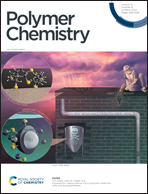Thermoresponsive metalloprotein-based hybrid hydrogels for the reversible and highly selective removal of lead(ii) from water†
Abstract
It is interesting to develop biomaterials for easily removing ultra-trace toxic metal ions from the environment. Herein, we have synthesized a thermoresponsive hybrid hydrogel PNIPAM-co-PbrRP by incorporating a reconstituted lead-binding peptide (PbrRP) derived from metalloregulatory protein PbrR691 into the network of poly(N-isopropylacrylamide) (PNIPAM). Combining the high sensitivity and selectivity for Pb(II) of PbrRP and the thermoresponsive property of PNIPAM, the hybrid hydrogel achieves innovative dual functions. It can turn into a shrunken or swollen state while the temperature is above or below the lower critical solution temperature (LCST) (34.36 °C). This shape change could provide a sufficient driving force to tune the conformation of immobilized PbrRP so that the peptide could adsorb or release lead ions reversibly. The hydrogel showed high selectivity toward Pb(II) even in the presence of a series of competing metal ions. By simply changing the environmental temperature across the LCST, we have enriched nanomolar Pb(II) from natural water samples with high efficiency, which represents a promising practical material for environmental remediation.



 Please wait while we load your content...
Please wait while we load your content...